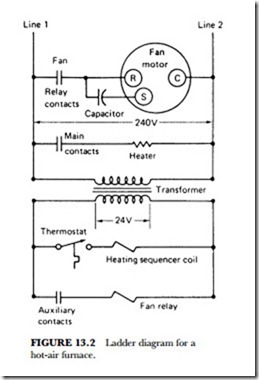BASIC ELECTRIC-HEATING SYSTEM
Electric-fired heat is the only heat produced almost as fast as the thermostat calls for it. It is almost instantaneous. There are no heat exchangers to warm up. The heating elements start producing heat the moment the thermostat calls for it. A number of types of electric-fired furnaces are available. They can be bought in 5- to 35-kilowatt sizes. The outside looks almost the same as the gas-fired furnace. The heating elements are located where the heat exchangers would normally be located. Since they draw high amperage, they need electrical controls that can take the high currents.
The operating principle is simple. The temperature selector on the thermostat is set for the desired temperature. When the temperature in the room falls below this setting, the thermostat calls for heat and causes the first heating circuit in the furnace to be turned on. There is generally a delay of about 15 seconds be- fore the furnace blower starts. This prevents the blower from circulating cool air in the winter. After about 30 seconds, the second heating circuit is turned on. The other circuits are turned on one by one in a timed sequence.
When the temperature reaches the desired level, the thermostat opens. After a short time, the first heat- ing circuit is shut off. The others are shut off one by one in a timed sequence. The blower continues to op- erate until the air temperature in the furnace drops below a specified temperature.
Basic Operation
Figure 13.2 shows that the electrical-heating system has a few more controls than the basic gas-fired fur- nace. The low-resistance element used for heating draws a lot of current, so the main contacts have to be of sufficient size to handle it.
The thermostat closes and completes the circuit to the heating sequencer coil. The sequencer coil heats the bimetal strip that causes the main contacts to close. Once the main contacts are closed, the heating element is in the circuit and across the 240-volt line. The auxiliary contacts will close at the same time as the main contacts. When the auxiliary contacts close, they complete the low-voltage circuit to the fan relay. The furnace fan will be turned on at this time.
Once the thermostat setting has been reached, it opens. This allows the heating sequencer coil to cool down slowly. Thus, the main contacts do not open immediately to remove the heating element from the line. So the furnace continues to produce heat after the thermostat setting has been reached. The bimetal cools down in about 2 minutes. Once it cools, it opens the main and auxiliary contacts, which removes the heating element from the line and also stops the fan motor. After the room cools down below the thermo- stat setting, the thermostat closes and starts the sequence all over again.
